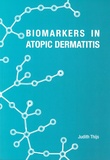Biomarkers in atopic dermatitis

Thijs, Judith
- Promoter:
- Prof.dr. C.A.F (Carla) Bruijnzeel - Koomen
- Co-promoter:
- Dr. D.J. (Dirk Jan) Hijnen & dr. S. (Stefan) Nierkens
- Research group:
- Nierkens
- Date:
- September 20, 2017
- Time:
- 12:45 h
Summary
Biomarkers for disease severity in atopic dermatitis
• A meta-analysis including 222 studies showed that serum TARC level is the best biomarker for disease severity currently available (chapter 2).
• Immunoglobulin free light chains have been shown to correlate with disease severity in paediatric AD. However, they do not correlate with disease severity in adult AD (chapter 6).
• A pilot study in 17 AD patients showed that a combination of serum biomarkers is better in assessing disease severity than a single biomarker (chapter 3).
• In a prospective cohort of 200 patients it was shown that combining serum TARC, IL-22 and sIL-2R levels in an algorithm accurately predicts clinically measured disease severity (predicted EASI) in 90% of AD patient treated with topical steroids (chapter 4).
• The p-EASI also predicts disease severity in patients treated with cyclosporin A (chapter 5).
• The p-EASI offers an objective outcome measure for disease severity in prospective AD studies (chapter 4 and 5).
Biomarkers enabling precision medicine in atopic dermatitis
• High expression levels of circulating inflammatory biomarkers suggest that AD is a systemic disease. Recently described comorbidities may be the result of this systemic inflammation, and emphasize the need for a multidisciplinary approach for optimal management of AD and its comorbidities (chapter 9)
• AD is a heterogeneous disease both clinically and biologically. We have identified four clusters of AD patients based on specific serum biomarker profiles, implying that each of these clusters is driven by a distinct underlying pathway and these clusters may represent different endotypes (chapter 7).
• UGT1A9 polymorphisms can be used to identify patients with non-responsiveness to mycophenolic acid therapy, thereby showing the potential of pharmacodynamic biomarkers in AD (chapter 8).
Improving practical aspects of biomarker measurement
• The biomarkers studied in this thesis are measured in serum. However, multiple other sources for biomarker measurement exist, for instance saliva and dried blood spots (chapter 10).
• A disadvantage of the use of serum biomarkers is the need for a venipuncture. TARC levels measured in dried blood spots also highly correlate with disease severity and significantly decrease during effective treatment. Therefore, dried blood spots may offer a simple and minimally invasive method for measurement of biomarkers in AD (chapter 11).